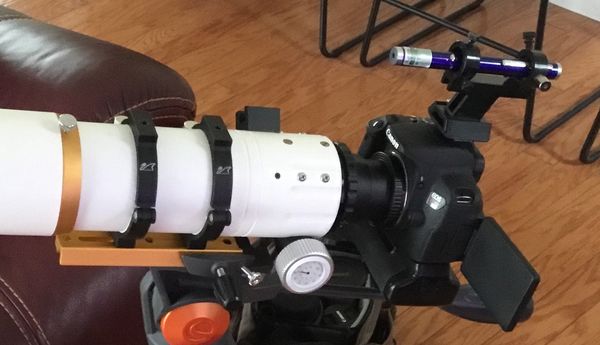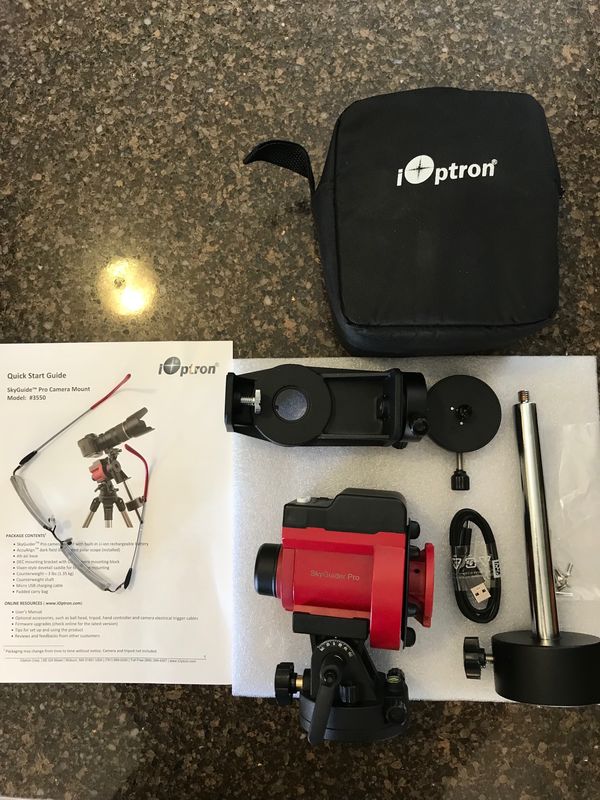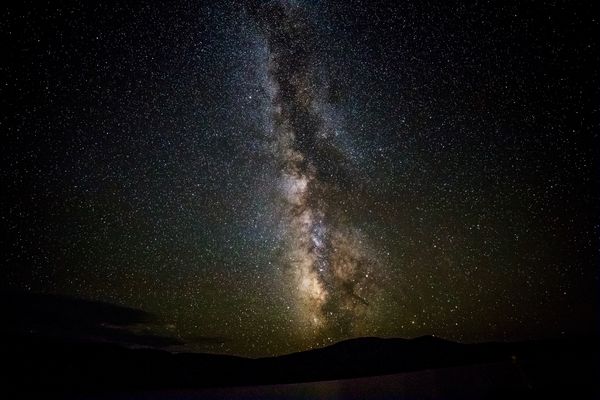iOptron SkyGuider
Apr 28, 2019 10:11:20 #
I just ordered the SkyGuider Pro from iOptron. I've done some night sky photography of the Milky Way using a 6D with a 4mm Rokinon f2.8 lens and got "ok" results. I bought the SkyGuider with the idea that I could take longer exposures without getting star trails and stop-down the lens and use lower ISO.
Just wondering if anyone here has the SkyGuider and if you might have some tips or tricks to use to get best results?
Just wondering if anyone here has the SkyGuider and if you might have some tips or tricks to use to get best results?
Apr 28, 2019 10:22:05 #
Ronsh
Loc: Floresville,Tx.
Basil wrote:
I just ordered the SkyGuider Pro from iOptron. I've done some night sky photography of the Milky Way using a 6D with a 4mm Rokinon f2.8 lens and got "ok" results. I bought the SkyGuider with the idea that I could take longer exposures without getting star trails and stop-down the lens and use lower ISO.
Just wondering if anyone here has the SkyGuider and if you might have some tips or tricks to use to get best results?
Just wondering if anyone here has the SkyGuider and if you might have some tips or tricks to use to get best results?
While I want one too. There is a guy on utube Peter ? Who tells all about how to use it and other guiders.
Apr 28, 2019 10:46:11 #
Ronsh wrote:
While I want one too. There is a guy on utube Peter ? Who tells all about how to use it and other guiders.
I've seen a few videos on YouTube; I'm just wondering if anyone here has used this particular guider and might have some additional insight, tips, etc.
Apr 28, 2019 13:04:38 #
Ronsh
Loc: Floresville,Tx.
Basil wrote:
I've seen a few videos on YouTube; I'm just wondering if anyone here has used this particular guider and might have some additional insight, tips, etc.
The guy I was talking about does. He talks about all the different ones. The only reason I don’t have yet is I don’t understand what I don’t know.
Apr 29, 2019 09:47:09 #
I have the older skytracker model. It works very well. I am expecting the skyguider Pro any day now.
As far as tips, I assume the YouTube covered, but leveling the tripod, giving it some weight to hold it in place and a good polar alignment are the main tips. I’ve also found that adding a laser to the hot shoe helps a lot when pointing you camera at the sky.(see photo)
As far as tips, I assume the YouTube covered, but leveling the tripod, giving it some weight to hold it in place and a good polar alignment are the main tips. I’ve also found that adding a laser to the hot shoe helps a lot when pointing you camera at the sky.(see photo)
Apr 29, 2019 20:22:44 #
Ronsh
Loc: Floresville,Tx.
Basil wrote:
I just ordered the SkyGuider Pro from iOptron. I've done some night sky photography of the Milky Way using a 6D with a 4mm Rokinon f2.8 lens and got "ok" results. I bought the SkyGuider with the idea that I could take longer exposures without getting star trails and stop-down the lens and use lower ISO.
Just wondering if anyone here has the SkyGuider and if you might have some tips or tricks to use to get best results?
Just wondering if anyone here has the SkyGuider and if you might have some tips or tricks to use to get best results?
Peter Zelinka Check out his utube. He has a lot info about them
Apr 30, 2019 15:32:59 #
Apr 30, 2019 15:47:51 #
May 1, 2019 09:56:43 #
A member of our Astronomy bought this.....then a couple more bought it after playing around with them at a star party. I haven't seen any of their images so I wouldn't begin to recommend. Just saying they seemed to be impressed. I observed the little gems and they seemed to be rock solid made.
My only experience with iOptron is the ZEQ25 EQ mount. I rarely use it but it was a real performer when I did and remains my travel mount when I travel - rare anymore since I moved to a clear sky 360 view home.
https://www.astronomics.com/star-adventurer-pro-pack.html
My only experience with iOptron is the ZEQ25 EQ mount. I rarely use it but it was a real performer when I did and remains my travel mount when I travel - rare anymore since I moved to a clear sky 360 view home.
https://www.astronomics.com/star-adventurer-pro-pack.html
May 6, 2019 00:48:38 #
I've been using the Sky Guider Pro for about 1.5 years and would be happy to answer any questions you might have. Polar alignment is the most important attribute that will lead to good results. I found its best to start with a wide field lens (e.g. 14 mm, 24 mm) and work your way to larger lenses. It's really important to get a good understanding of the fundamentals of how it operates without pushing its limits. As you learn and become more in tuned with the nuances of the equipment, it's much easier moving up in the size of your lens. Results will be better and frustrations will be lower. I've been there.
May 6, 2019 23:36:08 #
btrlvngthruchem wrote:
I've been using the Sky Guider Pro for about 1.5 y... (show quote)
I bought a Rokinon 14mm f2.8 specifically for night sky phootography and I have a Canon 24-105 that I'd also like to try out. I'm mostly interested in grand images of the Milky Way with some interesting foregrounds. Ronsh mentioned Peter Zelinka in an earlier post and I've subscribed to his YouTube channel. His tutorials seem to be top notch. I haven't had a chance to get out and try the Star Guider Pro yet (mostly due to weather and clouds) but can't wait to try it. I have downloaded 3 iPhone apps that I think will come in very handy: 1) Dark Sky (helps you locate areas with little or no light pollution). 2) PhotoPills - really great app for helping with, among other things, planning night shots. 3) Polar Scope Align Pro (Shows you exactly where the North Star should be in the polar scope reticle). Do you have any recommendations as a starting point (assuming I use the 14mm) for f-stop, ISO and exposure time with the Star Guider
May 6, 2019 23:40:46 #
Basil wrote:
I bought a Rokinon 14mm f2.8 specifically for nigh... (show quote)
Mine arrived today, so it’ll be cloudy here for a few weeks!
May 7, 2019 00:34:19 #
Europa wrote:
Mine arrived today, so it’ll be cloudy here for a few weeks!
I can relate!
May 7, 2019 01:00:54 #
I think you're going to like the SGP and the results you get using the lenses you have.
The setting you use are going to be defended by the conditions you are shooting under. To give you a bit of guidance, consider the following. There will be significant vignetting with the 14 mm on a full-frame camera but on an APS-C camera it should be hardly noticeable by stopping down to f4. Typically, lenses aren't their sharpest wide open so stopping down from f2.8 to f4 could significantly improve your photograph. However, try it wide open and try it stopped down one or two stops to see what results you like better. As far as ISO, again see what works best for you'll be limited by the amount of ambient light you have to deal with. I've seen ISO of 6400, 3200, 1600, and 800 used for Milky Way shots. The lower the ISO the lower the noise. As far as exposure time, you might take a 5 min exposure under really dark skies but more often than not, you're exposure time is limited by your conditions.
I've watched some of Peter Zelink's videos and think they are quite well done. If you haven't seen them, check out Lonely Planet and Ian Norman's videos as they are specific to Milky Way astrophotography.
You've also made some great choices in the apps you'll be using. I can't say enough good things about the Polar Scope Align Pro. I seem to find something new each time I use it.
One of the most difficult things to do, at least for me, is getting a great focus. Just something to think about.
I hope you're in a location where you have the possibility of getting to some reasonably dark skies as they are few and far between for me here in west Florida.
I've attached a MW shot I took about a year and a half ago under the darkest sky conditions I've ever encountered. It is a single 10 s shot from my tripod using a Canon 6D, the Rokinon 14 mm f2.8 set at f2.8 and at ISO 6400. From my backyard, the setting would be completely different. At least this gives you some frame of reference.
I hope this is helpful.
The setting you use are going to be defended by the conditions you are shooting under. To give you a bit of guidance, consider the following. There will be significant vignetting with the 14 mm on a full-frame camera but on an APS-C camera it should be hardly noticeable by stopping down to f4. Typically, lenses aren't their sharpest wide open so stopping down from f2.8 to f4 could significantly improve your photograph. However, try it wide open and try it stopped down one or two stops to see what results you like better. As far as ISO, again see what works best for you'll be limited by the amount of ambient light you have to deal with. I've seen ISO of 6400, 3200, 1600, and 800 used for Milky Way shots. The lower the ISO the lower the noise. As far as exposure time, you might take a 5 min exposure under really dark skies but more often than not, you're exposure time is limited by your conditions.
I've watched some of Peter Zelink's videos and think they are quite well done. If you haven't seen them, check out Lonely Planet and Ian Norman's videos as they are specific to Milky Way astrophotography.
You've also made some great choices in the apps you'll be using. I can't say enough good things about the Polar Scope Align Pro. I seem to find something new each time I use it.
One of the most difficult things to do, at least for me, is getting a great focus. Just something to think about.
I hope you're in a location where you have the possibility of getting to some reasonably dark skies as they are few and far between for me here in west Florida.
I've attached a MW shot I took about a year and a half ago under the darkest sky conditions I've ever encountered. It is a single 10 s shot from my tripod using a Canon 6D, the Rokinon 14 mm f2.8 set at f2.8 and at ISO 6400. From my backyard, the setting would be completely different. At least this gives you some frame of reference.
I hope this is helpful.
May 7, 2019 01:05:47 #
I'll be interested to see how both of you like the SGP. Would love to see some photos.
I can relate as well. Over the past week, we've had probably the 5 best nights of the year for astro work. Cool, no wind, no humidity, NO BUGS, good seeing, crystal clear and do you think I could even get out one of those nights? Not a chance. Work interferes with life.
Clear skies!
I can relate as well. Over the past week, we've had probably the 5 best nights of the year for astro work. Cool, no wind, no humidity, NO BUGS, good seeing, crystal clear and do you think I could even get out one of those nights? Not a chance. Work interferes with life.
Clear skies!
If you want to reply, then register here. Registration is free and your account is created instantly, so you can post right away.




